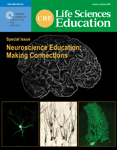Abstract
Undergraduate students may be attracted to science and retained in science by engaging in laboratory research. Experience as an apprentice in a scientist's laboratory can be effective in this regard, but the pool of willing scientists is sometimes limited and sustained contact between students and faculty is sometimes minimal. We report outcomes from two different models of a summer neuroscience research program: an Apprenticeship Model (AM) in which individual students joined established research laboratories, and a Collaborative Learning Model (CLM) in which teams of students worked through a guided curriculum and then conducted independent experimentation. Assessed outcomes included attitudes toward science, attitudes toward neuroscience, confidence with neuroscience concepts, and confidence with science skills, measured via pre-, mid-, and postprogram surveys. Both models elevated attitudes toward neuroscience, confidence with neuroscience concepts, and confidence with science skills, but neither model altered attitudes toward science. Consistent with the CLM design emphasizing independent experimentation, only CLM participants reported elevated ability to design experiments. The present data comprise the first of five yearly analyses on this cohort of participants; long-term follow-up will determine whether the two program models are equally effective routes to research or other science-related careers for novice undergraduate neuroscientists.



